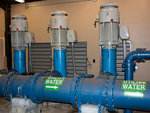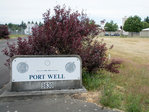



In the flood-prone Chehalis Basin, it may come as a surprise that a shortage of water could stall the Twin Cities’ growth.
Centralia and Chehalis are joining other cities in an effort to assess their current portfolios of water rights and potential new sources of municipal water that could support an expanding population and allow the cities to court more industrial growth.
The Lewis County Economic Development Council has recently helped the city of Chehalis hire a lawyer to assess its water portfolio. A report on the subject is expected to be done within the next month. The EDC earlier did the same for Winlock.
Meanwhile in Centralia, a pair of consulting contracts worth up to $152,000 approved by the Centralia City Council at its June 12 meeting lay out the way forward for the Hub City.
Both contracts are on an as-needed basis and will be paid out as such.
Centralia Public Works Director Kim Ashmore said that he wants to look decades, not years into the future when assessing and planning for water use in the city.
“If the city continues to grow, we want to make sure we continue to serve our citizens and that further development can happen,” Ashmore said. “We’re always looking to the future and we want to make sure we have enough water rights granted by the state for our citizens and growth.”
The city’s contract with Pacific Groundwater Group, which is based out of Seattle, states that a new production well would likely be built at the Fords Prairie treatment facility near the intersection of Mahoney Drive and Southworth Court in the west end of Centralia.
Two wells have been located at the site since 2002. Those and a well located nearby off Eshom Road make up the Port Wellfield that is one of the primary water sources for Centralia.
The city explored the possibility of upgrading operational wells, but it’s likely a new one will be needed.
“They have limited capabilities,” Ashmore said. “So we’re looking to see if we can get some more of that water out to serve our customers.”
Another option the city wants input on is whether it could apply for and receive water rights on the Skookumchuck River.
Centralia filed an application in 2007 with the Department of Ecology for water rights on the Skookumchuck. The Department of Ecology handles the adjudication of water rights around the state.
Rights are granted for an entity, such as a city, to use a certain amount of water from a specific point of a source. Rights for a defined location are enforced based on the order they were granted (first come, first serve).
The 2007 document, available on Ecology’s website, is labeled as a “new application” and no action appears to have been taken on it.
“It would definitely add to our portfolio of water rights,” Ashmore said. “We’re not going to go ask for more rights than we need, but we’re always planning for the future. Growth happens.”
The cities aren’t only trying to ensure that residents can access clean water decades down the line, but are hoping to make the area more attractive to commercial and industrial developers.
Anything from a chicken processing plant, an example Centralia City Manager Rob Hill cited, to a server farm can require massive amounts of water to operate.
“You need to know what you have in the bank when they come knocking,” Hill said. “It’s like money in the bank. If you don’t have the water, you can’t be inviting those types of industries into your community.”
Trent Lougheed, the Community Development director for Chehalis, said that the city cannot physically pump as much water out of the Newaukum River as it has the rights to during the summer, especially in August.
A presentation given by Lougheed to the Chehalis City Council in January states that the city has the right to pump more than 6.4 million gallons per day 3out of the Newaukum, but its water treatment plant can only handle 4.8 million gpd. Further, the river often gets low enough in the summer that Chehalis can only withdraw less than 2.6 million gpd.
The city has more than enough water rights on the Chehalis River to make up the difference — nearly 7.5 million gpd — but it is more expensive to pump water from there to the treatment plant than the gravity-based system out of the Newaukum.
The treatment process is not the same for both bodies of water, which forces workers at the plant to make temporary changes to the system when they tap the Chehalis River.
“Our preference is typically to take out of the Newaukum,” Lougheed said. “We pump the Chehalis when we can’t get anymore out of the Newaukum. Right now we don’t have enough water for large planning or significant development. So we’re trying to figure out how we can negotiate or change point of withdrawal and things like that.”
Water rights are valuable enough as a commodity that they are sometimes placed in a trust, like one would real estate or investment portfolios.
Three wells located on the Flying-T property at 1101 Goodrich Rd. — currently home to the Centralia Wastewater Treatment Plant — make up an asset the city has and wants to protect.
It owns the water rights for the wells on the property, which it bought from Washington State University in 1999. They are rarely used for more than watering hay.
Water rights can be taken away from their owner if the state determines the water isn’t being used in a beneficial way and in line with the permit granted. Right holders periodically have to submit usage reports to the state for review.
“We may not be using them much today, but we could possibly need them in a few years,” Ashmore said. “It’s not like we can go over to a bank and stick them in a trust. We have to go through the proper process, and we don’t want to lose any water rights when we’re out trying to find them.”
The wells are not connected to the Centralia water lines and could not be used for municipal purposes without the consent of Ecology.
Two projects mentioned in the consulting contracts address the long-term safety of the Centralia system.
Its agreement with HDR Engineering makes reference to 31 miles of asbestos-cement (AC) piping that needs to be replaced over the next 25 years.
Some sections may be as much as 60 years old and they’re not in great shape. Workers had to repair a section of leaking water main last week in the northeast portion of town. HDR Engineering will be available to help formulate a plan to replace the pipe.
“You put out there 31 miles over 25 years and these consultants are probably able to put a dollar amount to that,” Hill said. “Then you turn around and roll that back into your fee structure. Cities often don’t want to raise fees, but the pipe doesn’t care. Until we get it all out of the ground, there’s going to continue to be a replacement cost.”
A proposed monitoring network for the Centralia Critical Aquifer would serve as a warning system in the event of contamination. The aquifer is known to be highly porous and has numerous septic systems located above it.
Ashmore said the city wants to be able to know and react quickly if any measurement “makes us raise an eyebrow or two.”